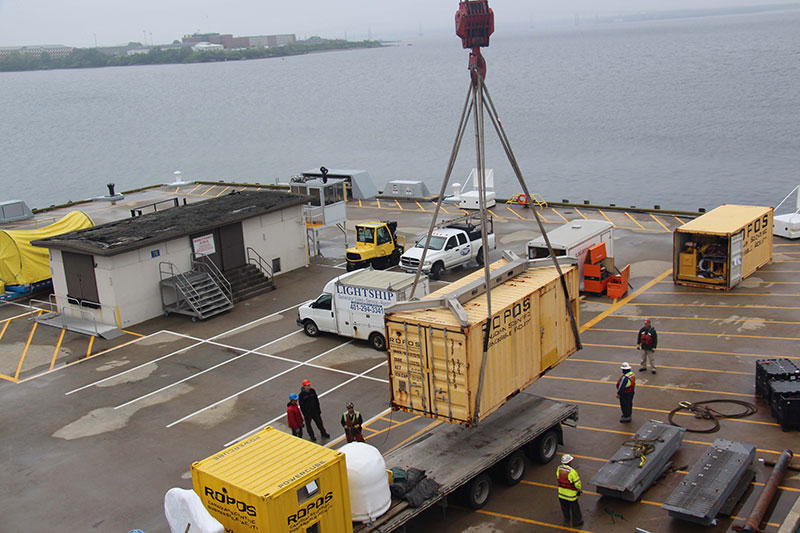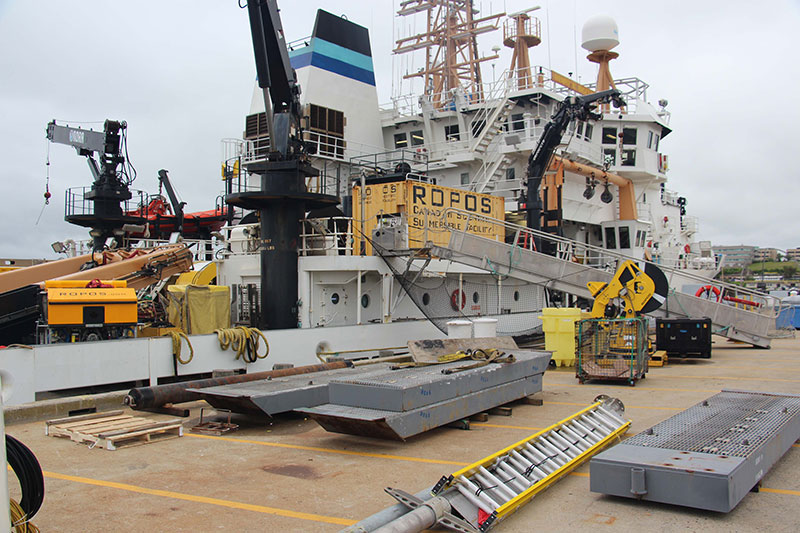
by Dr. Martha Nizinski, Chief Scientist, NOAA Office of Science and Technology, National Systematics Laboratory
June 7, 2017

Tracker trailer trucks remain at the ready to unload ROPOS and all the equipment necessary for ROV operations. Image courtesy of Northern Neighbors: Transboundary Exploration of Deepwater Communities. Download larger version (jpg, 2.3 MB).
Gray skies, drizzle, and cool temperatures did not dampen the enthusiasm of the crews of NOAA Ship Bigelow and the remotely operated vehicle (ROV) ROPOS on Monday as we began mobilization for our transboundary cruise.
Three tracker trailer trucks, carrying the ROV and everything needed to operate and maintain ROPOS throughout the mission and all the equipment needed to set up the communications and the command center arrived early Monday morning. Trucks were staged on the pier as the ship made last minute adjustments to prepare the decks to receive what will be our underwater eyes for the next 15 days.

The container destined for the 01 deck is lifted off the truck. Image courtesy of Northern Neighbors: Transboundary Exploration of Deepwater Communities. Download larger version (jpg, 2.9 MB).

The container, containing supplies and spare parts, is secured to the deck. Image courtesy of Northern Neighbors: Transboundary Exploration of Deepwater Communities. Download larger version (jpg, 3.3 MB).
Getting ready for a cruise of this magnitude is no small task. Everything needed to support ROPOS operations was gathered, inventoried, packed, loaded and driven cross-country from Victoria, British Colombia, to Newport, Rhode Island; scheduled to arrive three days prior to our departure. Scientists in Canada and the U.S. prepared totes full of supplies and experimental apparatus and sent those by mail to lighten the load during travel.
Arrangements were made for a barge crane capable of picking up these containers, the largest of which weighed 35,000 pounds, to be on site to lift the containers onto the ship. Once the containers were lifted and in place onboard the ship, everyone got busy unpacking and transforming the ship into an at sea laboratory. ROPOS crew working with the ship’s crew began hooking up power supplies, securing containers to the decks, re-assembling the ROV and winches, and setting up the configuration between the ship’s A-frame and the ROV for deployment. Inside, the ship’s acoustics lab was transformed into the ROV command center. Scientists found a spot in the wet lab to set up their sample processing stations.
Over three days, crews work long and hard in preparation for ROV operations. In the end, spare parts, collecting gear, and other sampling equipment will be stored or tied down. Everything will be set and ready go when leave the dock. The fisheries survey vessel has been transformed. Tomorrow our adventure begins!

ROPOS is unloaded from its container onto the dock. Image courtesy of Northern Neighbors: Transboundary Exploration of Deepwater Communities. Download larger version (jpg, 3.9 MB).